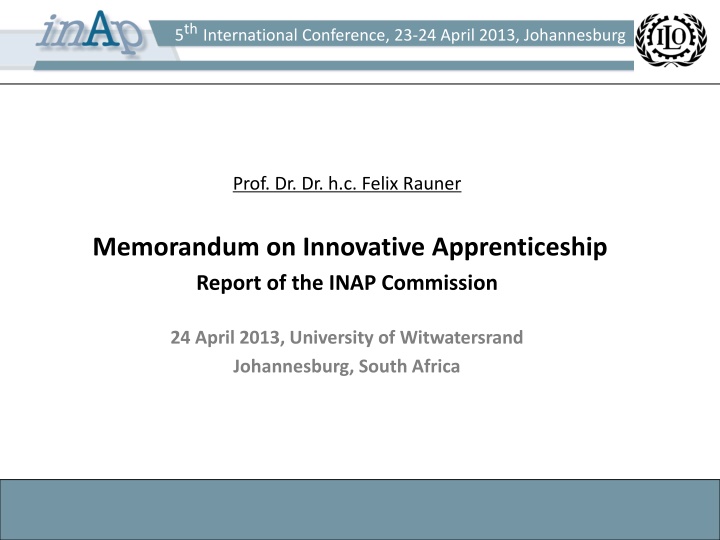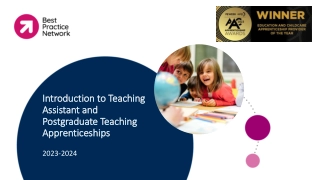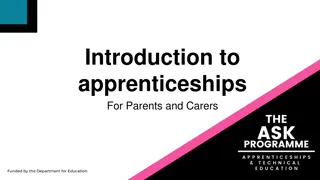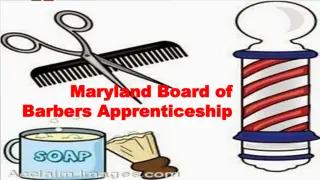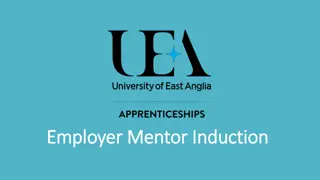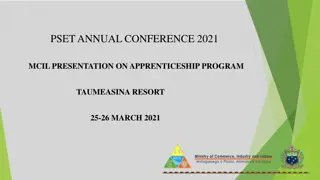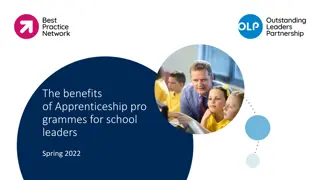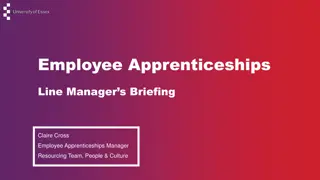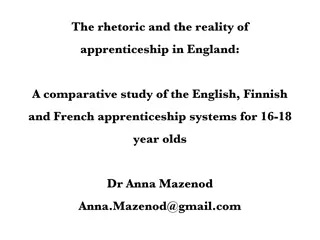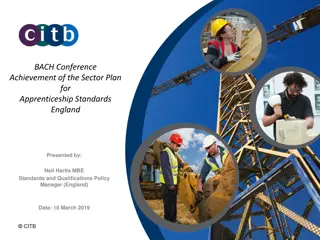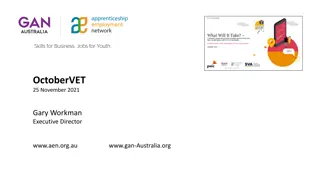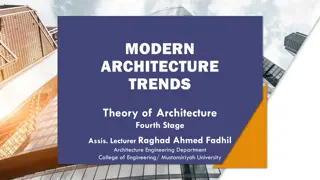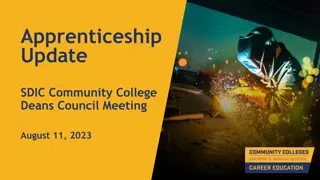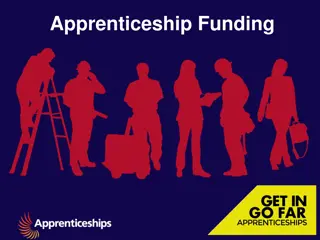Innovative Apprenticeship Architecture and Standards
This content explores the initiatives undertaken at the 5th International Conference in Johannesburg, focusing on improving coordination between vocational education and employment systems, enhancing employment opportunities for youth, and promoting competitiveness in companies. Prof. Dr. Felix Rauner leads discussions on modern dual vocational education criteria, structure, and governance. The conference highlights the importance of stable dual VET tracks, holistic competence development, and sustainable occupational profiles to facilitate a successful transition from school to work.
Download Presentation

Please find below an Image/Link to download the presentation.
The content on the website is provided AS IS for your information and personal use only. It may not be sold, licensed, or shared on other websites without obtaining consent from the author.If you encounter any issues during the download, it is possible that the publisher has removed the file from their server.
You are allowed to download the files provided on this website for personal or commercial use, subject to the condition that they are used lawfully. All files are the property of their respective owners.
The content on the website is provided AS IS for your information and personal use only. It may not be sold, licensed, or shared on other websites without obtaining consent from the author.
E N D
Presentation Transcript
5thInternational Conference, 23-24 April 2013, Johannesburg Prof. Dr. Dr. h.c. Felix Rauner Memorandum on Innovative Apprenticeship Report of the INAP Commission 24 April 2013, University of Witwatersrand Johannesburg, South Africa
5thInternational Conference, 23-24 April 2013, Johannesburg During the Board Meeting of the 4th INAP conference in Beijing 2011, it has been decided to set up a working commission on Innovative Apprenticeship Architecture. This Group consists of following members: Prof. Felix Rauner (chair) Prof. Salim Akoojee Prof. Robert I. Lerman Prof. Erica Smith Dr. Bonita Watt-Malcolm Helmut Zelloth Prof. Zhiqun Zhao Germany South Africa United States Australia Canada European Training Foundation China Prof. Dr. Dr. h.c. Felix Rauner
5thInternational Conference, 23-24 April 2013, Johannesburg Central questions: 1. How can the coordination between the vocational education and training systems and employment systems be improved? 2. What are the conditions for promoting employment opportunities for young people, thus facilitating the transition from school to work? 3. What are the effects on the competitiveness of companies? 4. How can rewarding careers be made accessible for a large segment of the population? Prof. Dr. Dr. h.c. Felix Rauner
5thInternational Conference, 23-24 April 2013, Johannesburg Memorandum An Architecture for Modern Apprenticeships Standards for Structure, Organisation and Governance The International Network on Innovative Apprenticeship CONTENT Chapter 1: Criteria for modern dual vocational education and training including the establishment of a stable and reliable dual VET track Chapter 2: Standards and governance for dual VET systems Chapter 3: Structure and development of occupational curricula Prof. Dr. Dr. h.c. Felix Rauner
5thInternational Conference, 23-24 April 2013, Johannesburg I. Criteria for modern dual vocational education and training including the establishment of a stable and reliable dual VET track 1. High quality and holistic competence in an occupational field 2. Competence to shape one s work shaping competence , ability to independently control and manage one s professional tasks 3. Seeing work context as a constitutive feature of professional work 4. The concept of core occupations reduces the horizontal and vertical division of labour 5. Creating sustainable occupational profiles 6. Open dynamic occupational profiles Prof. Dr. Dr. h.c. Felix Rauner
5thInternational Conference, 23-24 April 2013, Johannesburg I. Criteria for modern dual vocational education and training including the establishment of a stable and reliable dual VET track 7. Promoting occupational identity 8. Desirable time scale for learning to be competent in an occupation 9. Need for continuing professional development 10. Cooperation between learning venues 11. The legal status of apprentices 12. Cost-benefit of in-company apprenticeship training 13. Occupational domains and vocational disciplines 14. Integration of vocational education into a higher education structure parallel track Prof. Dr. Dr. h.c. Felix Rauner
5thInternational Conference, 23-24 April 2013, Johannesburg II. Governance of Dual VET Systems 1. Consistent legal framework 2. Cooperation of actors 3. Allocation of strategic and operative functions 4. Innovation strategies Prof. Dr. Dr. h.c. Felix Rauner
5thInternational Conference, 23-24 April 2013, Johannesburg II. Governance of Dual VET Systems 1. Consistent legal framework 2. Cooperation of actors 3. Allocation of strategic and operative functions 4. Innovation strategies III. Structure and development of occupational curricula 1. The Curriculum 2. Methods of Curriculum Development Prof. Dr. Dr. h.c. Felix Rauner
5thInternational Conference, 23-24 April 2013, Johannesburg Learning by doing vs. Innovative Apprenticeship Low potential work-based training Innovative Apprenticeship fragmented, specialized, company oriented, Taylorist (up to some thousands) open dynamic (European) core occupations (between 250 and 300) 1. Occupations 2 years and less 3 to 4 years including the option: occupational baccalaureate) 2. Duration fragmented, modularized, know that-based occupational shaping competence: reflected holistic problem solving (reflected professionals) 3. Competence narrow know that-knowledge work process knowledge: as a holistic and shaping oriented knowledge 4. Knowledge Prof. Dr. Dr. h.c. Felix Rauner
5thInternational Conference, 23-24 April 2013, Johannesburg Prof. Dr. Dr. h.c. Felix Rauner
5thInternational Conference, 23-24 April 2013, Johannesburg Low potential work- based training Innovative Apprenticeship unreflected work experience (learning by doing): rigid and constrained work attitude and behaviour separate learning venues: training approach reflected and systematised work experience 5. Work Experience integrated and co-operative learning venues: enabling for (co) shaping the world of work and society in social, economic and ecological responsibility Apprenticeship as a first step in a dual education and training track up to dual master programs (professional) level 6. Duality of Learning isolated training approach 7. Apprenticeship as part of a dual track VET system Prof. Dr. Dr. h.c. Felix Rauner
5thInternational Conference, 23-24 April 2013, Johannesburg Architecture Apprenticeship Prof. Dr. Dr. h.c. Felix Rauner
5thInternational Conference, 23-24 April 2013, Johannesburg fragmented governance integrated governance approach: Consistent legal framework Cooperation of Actors/Institutions Allocation of teaching and operative functions Innovative strategies 8. Governance 6 to 10 Hierarchical structure Risk: Deskilling Three levels Skilled workers Master craftsman (industry)/Bachelor (professional) Dual Master Programmes: Master (professional) 9. Levels of Qualifications 10. Attractiveness very low (stigmatisation) highly attractive occupational pathway, high potential for occupational identity and occupational commitment risks: low wages, unemployment, social disintegration, low vocational identity and commitment Prof. Dr. Dr. h.c. Felix Rauner
5thInternational Conference, 23-24 April 2013, Johannesburg Inputs and Perspectives from different countries (South Africa, Australia, China, Indonesia and the United States) Discussion
